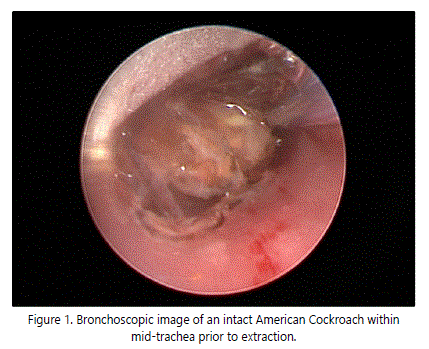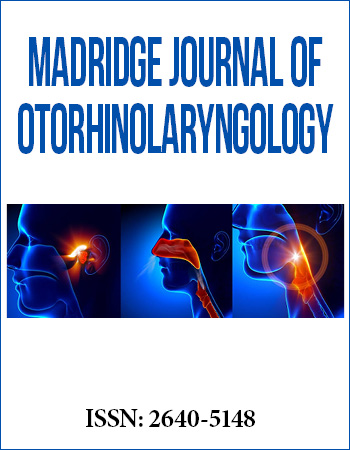Case Series
An Unusual Airway Foreign Body - A Cockroach in the Trachea
1University of Texas at Southwestern, Department of Otolaryngology - Head and Neck Surgery, Dallas, TX, USA
2Children's Health, Department of Pediatric Otolaryngology, Dallas, TX, USA
3University of Tennessee Health Science Center, Department of Otolaryngology, Memphis, TN, USA
*Corresponding author: Anthony Sheyn, Department of Otolaryngology Head and Neck Surgery, University of Tennessee Health Science Center, 910 Madison Ave, Suite 400, Memphis, TN 38103, USA, Tel. 513-225-2288, E-mail: asheyn@uthsc.edu
Received: February 14, 2018 Accepted: May 30, 2018 Published: June 5, 2018
Citation: Liu CC, Shah BG, Sheyn A. An Unusual Airway Foreign Body - A Cockroach in the Trachea. Madridge J Otorhinolaryngol. 2018; 3(1): 47-49. doi: 10.18689/mjol-1000109
Copyright: © 2018 The Author(s). This work is licensed under a Creative Commons Attribution 4.0 International License, which permits unrestricted use, distribution, and reproduction in any medium, provided the original work is properly cited.
Abstract
We present a case of airway obstruction by an unusual foreign body in a 10 month old male. The child was brought incubated to the emergency room after he was found unconscious and blue by his parents. His older sibling reported a choking episode after he placed a black object in his mouth. Chest x-ray on arrival demonstrated right-sided air trapping but no definite radio-opaque foreign body. Due to difficulty with ventilation and post-obstructive pulmonary edema on initial bronchoscopy, emergent extracorporeal membrane oxygenation (ECMO) was initiated to help stabilize the patient. Subsequent bronchoscopy demonstrated near total obstruction of the mid-trachea by an insect-like object. The object removed appeared to be a common American cockroach.
Airway foreign body retrieval is a common part of otolaryngology practice. Most of the time, these foreign bodies are food materials or other inanimate objects. Finding a cockroach in the airway is incredibly rare and only three cases have been reported in the literature. This case also illustrates that ECMO may be considered in a patient too unstable to tolerate temporary withdrawal of ventilatory support for endoscopy. Additionally, rapid diagnosis and treatment is important when caring for a child with suspected foreign body aspiration.
Keywords: Cockroach, Trachea, chest X-ray, and Unusual Airway Foreign Body.
Introduction
Foreign body aspiration is a common and potentially life-threatening event in the pediatric population. It is more common in children less than 3 years old and more often presents in males. Advances in endoscopic techniques have been associated with a steady decrease in morbidity and mortality related to foreign body aspiration in children. Sometimes, the foreign body may occlude the entire airway and ventilation may be impossible. If this is the case, alternate methods of maintaining blood and tissue oxygenation such as extra-corporeal membrane oxygenation (ECMO) may be considered if the patient's condition allows it. Here in, we present a case of an unusual airway foreign body in a patient who required ECMO for stabilization prior to foreign body removal.
Case Report
A ten-month old male was brought to the hospital for suspected foreign body aspiration. No adults witnessed the event but his step-sister reported that she saw the patient place something black from the ground into his mouth before he began choking. His father performed CPR before EMS arrived about 10 minutes later. At that time, the child had turned blue and was not responsive. He was promptly incubated and transported to the hospital. EMS reported that they may have pushed something into the trachea during incubation and the patient was difficult to ventilate during transport.
Upon arrival to the hospital, the child was immediately brought to the operating room. Initial bronchoscopy was complicated by unstable, marginal oxygen saturations and poor visualization secondary to airway edema and copious secretions. Additionally, he did not tolerate temporary suspension of ventilator support for greater than ten seconds during bronchoscopy attempts. His oxygen saturation was able to be maintained adequately without airway manipulation and a decision was made to proceed with emergent venovenous ECMO by pediatric surgery. Repeat rigid bronchoscopy demonstrated a near obstructive insect-like foreign body mid-trachea (Figures 1). Multiple attempts with optical forceps were unsuccessful and the object was ultimately removed by inflating a Fogarty catheter distal to it which was then withdrawn along with the rigid bronchoscope. The airway was evaluated following removal of the foreign body and was found to have sustained only minor mucosal injury (Figure 2). The object removed appeared to be the common cockroach.


The child was then incubated and transported to the intensive care unit and weaned off of ECMO the next day. Postoperatively, the child unfortunately developed severe neurologic sequelae and seizure disorder from prolonged anoxic brain injury.
Discussion
This case reports the unusual finding of a cockroach as an airway foreign body which has only been reported twice in the literature [1,2]. The age group that tracheobronchial foreign bodies most commonly occur in is 0-3 years, and they account for 7% of deaths in this age group [3]. The most frequent presenting symptom is a non-resolving cough. Other symptoms of concern include stridor, stertor, and recurrent infections. The main reasons for the high rate for foreign body inspiration in this age group are interest in the external environment and high rate of exploring objects with their mouth. Additional causes are the lack of full dentition, increased rate of aspiration with crying or yelling when in distress and insufficient development of neuromuscular structures that protects the airway [4].
In a review of 1068 foreign body aspirations in children, the authors found 3% in the larynx, 13% in the trachea, 52% in the right main bronchus, 6% in the right lower lobe bronchus, fewer than 1% in the right middle lobe bronchus, 18% in the left main bronchus, and 5% in the left lower lobe bronchus; 2% were bilateral [5]. Once identified or with a high degree of suspicion, the next step is rigid bronchoscopy with removal of the foreign body [6]. In children, the use of the rigid bronchoscope also allows for ventilation, in addition to the ability to remove the foreign body.
Hypoxia is the most common complication that occurs during bronchoscopy for removal of foreign bodies, occurring in 6 -20% of patients undergoing the procedure. A number of factors have been found to be associated with the occurrence of hypoxia during foreign body removal: skill of the surgeon, the type of anesthesia and ventilation used the patient's clinical condition, patient age, and nature of the foreign body [7].
There are multiple methods of dealing with hypoxia in children undergoing airway foreign body retrieval. Most important is the skill of the operating surgeon to perform a safe and efficient procedure. Each additional minute needed to perform the procedure increases the risk of hypoxia by 4% [8]. Use of inhalational anesthetic has been associated with a lower incidence of hypoxia as well [9].
Finally, this case also demonstrates the utility of extracorporeal membrane oxygenation (ECMO) in maintaining oxygen saturation during the removal of airway foreign bodies. To our knowledge this has only been described in three other cases [9]. Patients that present with difficult ventilation, marginal oxygen saturations, and high airway pressures could potentially be bridged with ECMO. Our patient did not tolerate brief withdrawal of ventilatory support for bronchoscopy and had marginal oxygen saturations that plummeted within seconds of removing support. Once ECMO was initiated, oxygen saturation was stabilized and bronchoscopy could proceed. This provided ample time for removal of the airway foreign body. However, ECMO cannulation has its limitations and requires time and availability of pediatric surgery services which is not the case for all institutions.
Conclusion
We presented a rare case of aspiration of a foreign body which was found to be an intact cockroach. Airway foreign body retrieval is a common part of otolaryngology practice. Most of the time, these foreign bodies are food materials or other inanimate objects. Finding a cockroach in the airway is incredibly rare and only three cases have been reported in the literature. This case also illustrates that ECMO may be considered in a patient too unstable to tolerate temporary withdrawal of mechanical ventilation for endoscopy. Additionally, rapid diagnosis and treatment is important when caring for a child with suspected foreign body aspiration.
References
- Marlow TJ, Schabel SI, Goltra DD. Endobronchial cockroach: an unusual foreign body aspiration. J. Emerg Med. 1997; 15(4): 487-9.
- Gokhale AG, Rajagopal P. Cockroach in right main bronchus - an unusual foreign body. Indian J Chest Dis Allied Sci. 1992; 34(2): 103-5.
- Oncel M, Sunam GS, Ceran S. Tracheobronchial aspiration of foreign bodies and rigid bronchoscopy in children. Pediatric International. 2012; (54): 532-35. doi: 10.1111/j.1442-200X.2012.03610.x
- Higo R, Matsumoto Y, Ichimura K, Kaga K. Foreign bodies in the aero digestive tract in pediatric patients. AurisNasus Larynx. 2003; 30: 397-401.
- Eren S, Balci AE, Dikici B,Mehmet D, Mehmet NE. Foreign body aspiration in children: experience of 1160 cases. Ann Trop Paediatr. 2003; 23(1): 31-7. doi: 10.1179/000349803125002959Rodrigues AJ, Scussiatto EA, Jacomelli M, Scordamaglio PR, Gregório MG, et al. Bronchoscopic Techniques for Removal of Foreign Bodies in Children's Airways. Pediatric Pulmonology. 2012; 47: 59-62. doi: 10.1002/ ppul.21516Bittencourt PFS, Camargos P, Picinin IFM. Risk factors associated with hypoxemia during foreign body removal from airways in childhood. Int J Pediatr Otorhinolaryngol. 2013; 77: 986-89. doi: 10.1016/j.ijporl.2013.03.026Maddali MM, Mathew M, Chandwani J, Alsajwani MJ, Ganguly SS. Outcomes after rigid bronchoscopy in children with suspected or confirmed foreign body aspiration: a retrospective study. J Cardiothorac. Vasc. Anesth. 2011; 25: 1005-8. doi: 10.1053/j.jvca.2011.02.005Park AH, Tunkel DE, Park E, Barnhart D, Liu E, et al. Management of complicated airway foreign body aspiration using extracorporeal membrane oxygenation. Int J Pediatr Otorhinolaryngol. 2014; 78: 2319-21. doi: 10.1016/j. ijporl.2014.10.021


